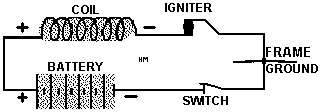BATTERY and COIL (Low Tension Ignition)
| Hot Tubes | Igniters | Low Coils | Summary | Disclaimer |
| Low Mags | Buzz Coils | High Mags | Comments | EXIT |

The COIL that is used with an igniter is only a single winding although you will see some engine folks using the primary side of an automotive coil for convenience sake. This coil is made up of a long iron core wound with a considerable length of low resistance insulated copper wire. Just about any soft iron cored coil will provide enough inductance to snap a spark on the igniter, the length of the core and the number of turns of insulated wire determining the strength of the spark. The coil of wire is wound over a soft iron core to increase its inductance (self induction) many fold over an air core. Soft iron does NOT hold a magnetic charge well and therefore when the circuit is opened, the rapidly collapsing field provides an "inductive kick" on the order of many hundreds of volts. (I supposed this became known as a "kick" because some poor soul had a grip on the wires and got KICKED in the process.) (Maybe TENSION is what he felt afterward!) A BATTERY provides the current that builds up the magnetic charge in the coil. Battery life is important, so some igniters are normally open, shutting and reopening only as a spark is needed. As long as the points are open, no BATTERY power is being consumed. However, the opened points can become fouled more easily than closed points so other battery saving methods have been used. Since the exhaust valve is held open on hit and miss governed engines to prevent over-speed conditions by free breathing, this linkage can also be used to hold OPEN the battery circuit. When the flywheel speed falls below the governor set point, the exhaust valve is allowed to close and the intake valve will allow the piston to suck in a new charge of fuel mixture on the next intake stroke. The battery charges up the coil, the fuel mixture is compressed, and then the breaking igniter points fire the mixture, the engine speeds back up and the exhaust valve is held open again until power is demanded. The exhaust valve closure is a typical "make" for the igniter circuit and just before compression top dead center is the typical igniter "break." Many engines do not have this battery saving feature. These are set up to accomplish a quick MAKE then BREAK all in one move of the TRIP lever. This happens every fourth cycle, whether power is called for or not. Remember that the spark occurs at the instant of breaking the circuit, not at the instant of making. 
So, the line up is: a battery, the coil, and the igniter points, and then back to the battery via the frame or ground wire. The igniter closes, initial current flows in one direction, the magnetic field builds up to saturate the iron core, the igniter opens, the magnetic field rapidly collapses causing a high voltage in the reverse direction. The resulting voltage arcs or jumps across the open gap of the igniter points, and the gas explodes. NEXT PAGE: |
| Hot Tubes | Igniters | Low Coils | Summary | Disclaimer |
| Low Mags | Buzz Coils | High Mags | Comments | EXIT |
There's a WHOLE LOT more to this site so click and cruise around!
| ENGINES | SHOWS | SEARCH | SUPPLIERS | IGNITIONS | ABRASIVES | CLASSIFIEDS | FORUM |
SCRAM back to Harry's
 Page!
Page!Published by Harry Matthews © 1995 - 2007. ALL RIGHTS RESERVED!